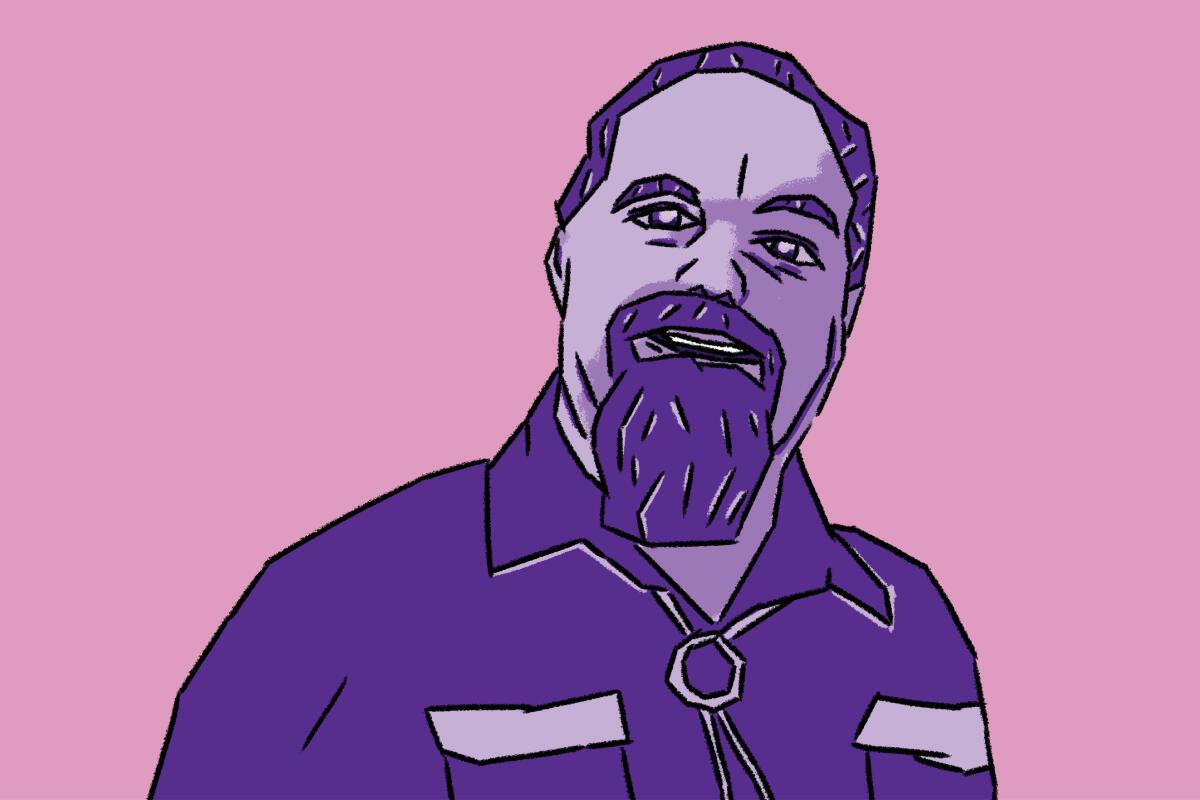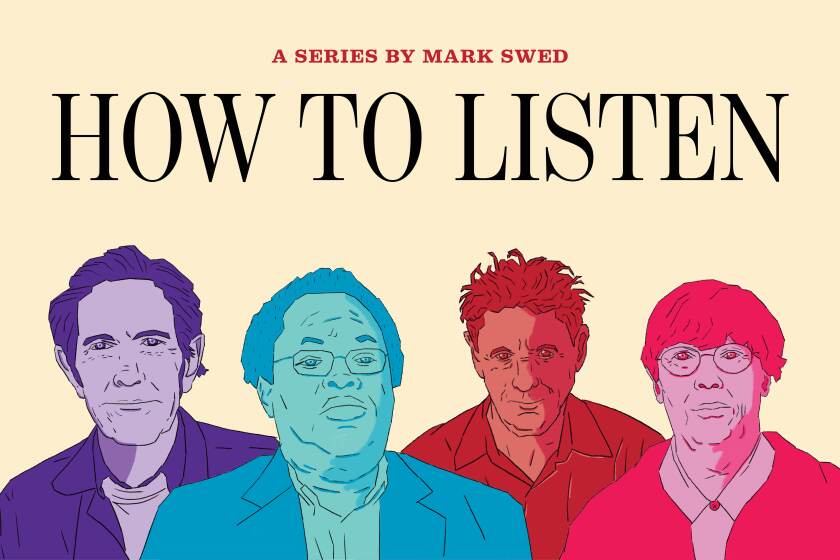Lou Harrison’s generosity endures when we most need it

A ravenous reader, Lou Harrison made a habit of buying multiple copies of books he enjoyed so that he could send them to friends. What does that have to do with his Suite for Violin With American Gamelan?
Harrison was an expansive musician of voracious cultural appetites who embodied, more than any composer before him or since his death in 2003, what it meant, in the truest and vastest sense, to be a Californian. And embedded in this suite of exquisite sharing, written in 1974, are many aspects of Harrison’s generosity.
Michael Tilson Thomas, who as music director of the San Francisco Symphony helped to make Harrison a San Francisco icon, has said that when he starts to run out of energy on a hike, he will sing to himself the suite’s Chaconne, the uplifting last movement. It gets him up that last hill. Try it, MTT recommended. I did. It worked.
Uplift is obviously something our coronavirus-consumed situation needs, to say nothing of generosity. A study published three years ago in the journal Nature Communications found, in fact, a neural link between generosity and happiness.
But even during our holiday season, generosity, like so much else, has become an issue of social contention, as healthcare authorities must now plead with us to take personal responsibility for the well-being of others and society. Cue the Chaconne from a composer who sought wisdom and what works from all places.
He looked across the Pacific, entranced by the musics of Asia. He crooked his neck toward the East Coast and across the Atlantic. He espied all around him. As a young composer in 1941 San Francisco, Harrison and his close friend John Cage scoured Bay Area junkyards for found percussion instruments, hitting everything in sight to see what sounds could be made (brake drums proved exceptionally useful). A cheap dinner in Chinatown was typically followed by a performance of traditional Chinese opera.
Harrison was loveable (a dancer and dashing in his youth, chubby with a Santa Claus beard in his later years) and easily enraptured. He proudly described his exuberant eclecticism with childlike glee as “me, too” and as spreading “his toys over a wide acreage.” He told me that when he first discovered the Indonesian gamelan, with which he became obsessed, a really good-looking Javanese dancer made an equally big impression.
By the time Harrison wrote the Suite for Violin With American Gamelan, he was 57 and had been through a lot. A disciple of Henry Cowell, the father of West Coast and world music, Harrison made his playground, from the start, the world stage. Cage enticed him into radical experimentation. Schoenberg, with whom Harrison studied at UCLA, thought him a brilliantly finished musician with nothing left to teach.
Harrison moved to New York, where he composed up a storm in multiple styles and helped Charles Ives to turn decades’ worth of chaotic sketches into such lasting works as the First Piano Sonata and the Third Symphony. The latter, which has Harrison’s fingerprints all over it, won a Pulitzer Prize in 1947, and Ives insisted on sharing the award with Harrison.
Always openly gay (bravely so for his generation), Harrison also had a turbulent personal life.
He began one of our occasional lunches by jovially announcing that he knew exactly what I wanted to ask (he knew full well I wouldn’t have dared!). “I did sleep with John Cage,” he said with a huge grin. “Only once. It was wonderful.”
What wasn’t wonderful for the highly sensitive Harrison was New York’s hectic city life, especially the noise. He had a nervous breakdown and moved back to hectic San Francisco, eventually finding peace in a rural house on a quiet hill in Aptos, near Santa Cruz. In 1966, he met William Colvig, who became his life partner and, as an incomparable instrument builder, essential collaborator. For the next 33 years, Harrison and Colvig went gangbusters.
Coronavirus may have silenced our symphony halls, taking away the essential communal experience of the concert as we know it, but The Times invites you to join us on a different kind of shared journey: a new series on listening.
Harrison liked to say music is a song and a dance, and in the last decades of the 20th century no one could touch him as a melodist. Then again, no one was quite like Harrison in his rich application of Western music (particularly Elizabethan music and the early tuning systems of Baroque music) and the many Asian musics in which he became expert. At the time, that was outsider art, particularly in snotty East Coast circles. Now more than half the composers in Brooklyn are following in Harrison’s footsteps.
The American gamelan used in the suite came about when Colvig proposed to Harrison that he write an opera on a gay theme, which led to “Young Caesar.” The result was a puppet opera about a love affair between the teenage Julius Caesar and the leader of Bithynia that had its premiere at Caltech, of all places, in 1970 and scandalized a conservative Pasadena audience with its sex scenes. While “Young Caesar” took decades to find its workable final form, its orchestra of handmade percussion instruments, which Harrison and Colvig dubbed Old Granddad, had immediate legs.
They changed the name to American Gamelan, given its gong-like character, and that became the foundation for Harrison’s next major work, “La Koro Sutra,” an exquisite setting for chorus and percussion of the Buddhist “Heart Sutra” translated into Esperanto (the “universal” language being, like sign language and calligraphy and type fonts, yet another of Harrison’s passions).
Here Harrison made a significant statement about generosity. “To smile is not to smile only for yourself,” the Vietnamese Zen master Thich Nhat Hanh has written about “The Heart Sutra,” and that also describes Harrison here at his most luminous. “The world will change because of your smile.”
The Suite for Violin With American Gamelan that followed became the work to put the smile back on Harrison’s face. He wrote it in the wake of a new depression spiked by his mother’s death and a bout of heavy drinking. He enlisted the aid of a former student and violinist, Richard Dee, whom he felt had talent as a composer.
Harrison was always cagey about who did what in the suite, although in a masterful Harrison biography published three years ago, Bill Alves and Brett Campbell spill the beans. While Dee’s contribution is not unsubstantial, the structure, tone, character, percussion writing, harmony and counterpoint are pure Harrison. Presumably under Harrison’s watchful eye, Dee added Harrison-like melody and alluring extensions in the violin part. The result is a work that sounds seamless, yet also in this act of compositional generosity extends beyond Harrison’s ego.
If the essence of the “Heart Sutra” is, as Nhat Hanh explains, that “this is that, and that is this,” Harrison interprets that in terms of musical interconnectedness. The solemn, drone-based opening Threnody captures Harrison’s elegiac mood, but sad song is quickly followed by lively Estampie, a medieval dance form with a succession of sections (perfect for the back and forth of Harrison and Dee). A central aria has elements of Chinese music. Three Jahlas (Harrison’s own term for his gamelan-flavored dances) lead to the hill-conquering Chaconne.
Coming up with an American Gamelan is no easy matter, so the suite has been adapted into the more user-friendly Suite for Violin and String Orchestra. Even so, a surprising number of percussionists have taken Harrison at his word, that his toys were for sharing over worldwide acreages, and they created their own American Gamelan for performances.
Meanwhile. Harrison’s legacy of generosity continues on a real acreage, the straw bale house that Harrison and Colvig built at the end of their lives in Joshua Tree. It serves as a site for artist residencies, concerts and an arts-oriented permaculture project meant to live up to Harrison’s motto: Cherish, Consider, Conserve, Create.
Starting points
Easily the best introduction to this composer is the glorious documentary “Lou Harrison: A World of Music” by Eva Soltes.
A superb introduction to the Suite for Violin With American Gamelan is a video featuring violinist Shalini Vijayan in a moving performance in San Francisco on Harrison’s 100th birthday.
The classic first recording of the suite recorded in Berkeley in 1987 features musicians who worked with Harrison.
A slicker, more modern one from the Boston Modern Orchestra Project has less character but much beauty.
The version with string orchestra has not been recorded complete, but most of the score survives in a fine performance from New Zealand with Maria Bachmann as soloist.
With live concerts largely on hold, critic Mark Swed is suggesting a different recorded music by a different composer every Wednesday. You can find the series archive at latimes.com/howtolisten, and you can support Mark’s work with a digital subscription.
More to Read
The biggest entertainment stories
Get our big stories about Hollywood, film, television, music, arts, culture and more right in your inbox as soon as they publish.
You may occasionally receive promotional content from the Los Angeles Times.












